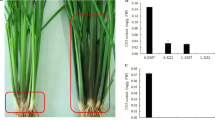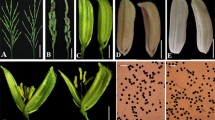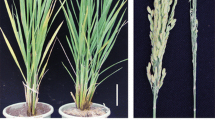Abstract
Natural and artificially induced mutants have provided valuable resources for plant genetic studies and crop improvement. In this study, we investigated the genetic and molecular basis of the purple sheath trait in a somaclonal mutant Z418, which was regenerated from a green sheath rice variety C418 through tissue culture. The purple sheath trait in Z418 was heritable and stable based on our 10 years of evaluation. Genetic analysis revealed that the purple sheath trait of the mutant was controlled by a single dominant gene. To map the gene, we scored 89 polymorphic SSRs markers in a F2 population of 232 plants derived from a cross between Z418 and HX-3, an indica variety with green sheath trait. The gene was initially mapped to the short arm of chromosome 6 between two SSR markers, RPM5 and RM402, with a genetic distance of 1.1 and 10.3 cM, respectively. Thirty-one SSR and indel markers located within the target region were further used to fine-map the gene to a 153-kb interval between two SSR markers (RPM8 and RPM11). The OsC1 gene, which locates within the region and encodes a MYB family transcription factor, was chosen as the candidate gene controlling the purple sheath trait in Z418. Sequencing analysis revealed that OsC1 gene and its transcript in Z418 was 34 bp longer than that in C418. The possible mechanisms for the gene mutation, the developmental and tissue-specific expression of purple anthocyanin pigmentation in Z418, were finally discussed.







Similar content being viewed by others
References
Adkins SW, Kunanuvatchaidach R, Godwin ID (1995) Somaclonal variation in rice—drought tolerance and other agronomic characters. Aust J Bot 43:201–209
Araijo LG, Prabhu AS, Freire AB (1998) Variation for rice blast resistance in early somaclonal generations derived from immature panicles. Pesqui Agropecu Bras. 33:1349–1359
Athma P, Peterson T (1991) Ac induces homologous recombination at the maize P locus. Genetics. 128:163–173
Bao PH, Granata S, Castiglione S, Wang G, Giordani C, Cuzzoni E, Damiani G, Bandi C, Datta SK, Datta K, Potrykus I, Callegarin A, Sala F (1996) Evidence for genomic changes in transgenic rice (Oryza sativa L.) recovered from protoplasts. Transgenic Res 5:97–103
Bertin P, Bouharmont J (1997) Use of somaclonal variation and in vitro selection for chilling tolerance improvement in rice. Euphycita. 96:135–142
Bregitzer P, Halbert SE, Lemaux PG (1998) Somaclonal variation in the progeny of transgenic barley. Theor Appl Genet 96:421–425
Breiman A, Rotem-Abarbanel D, Karp A, Shaskin H (1987) Heritable somaclonal variation in wild barley (Hordeum spontaneum). Theor Appl Genet 74:1432–2242
Cheng SH, Zhuang JY, Fan YY, Du JH, Cao LY (2007) Progress in research and development on hybrid rice: a super-domesticate in China. Ann Bot 100:959–966
Cocciolone SM, Chopra S, Flint-Garcia SA, McMullen MD, Peterson T (2001) Specific patterns of a maize Myb transcription factor are epigenetically regulated. Plant J. 27:467–478
Courtial B, Feuerbach F, Eberhard S, Rohmer L, Chiapello H, Camilleri C, Lucas H (2001) Tnt1 transposition events are induced by in vitro transformation of Arabidopsis thaliana and transposed copies integrate into genes. Mol Genet Genomics. 265:32–42
Damiani RD Jr, Wessler SR (1993) An upstream open reading frame represses expression of Lc, a member of the R/B family of maize transcriptional activators. Proc Natl Acad Sci USA 90:8244–8248
Dennis ES, Brettell RS, Peacock WJ (1987) A tissue culture induced Adh1 null mutant of maize results from a single base change. Mol Gen Genet 210:181–183
Evans DA, Sharp WR, Medina-Filho HP (1984) Somaclonal and gametoclonal variation. Am J Bot 71:759–774
Fujino K, Sekiguchi H, Kiguchi T (2005) Identification of an active transposon in intact rice plants. Mol Gen Genet 273:150–157
Furukawa T, Maekawa M, Oki T, Suda I, Iida S, Shimada H, Takamure I, Kadowak K (2006) The Rc and Rd genes are involved in proanthocyanidin synthesis in rice pericarp. Plant J. 49:91–102
Gao DY, Xu ZG, Chen ZY, Sun LH, Sun QM, Lu F, Hu BS, Liu YF (2002) Identification of a resistance gene to bacterial blight (Xanthomonas oryzae pv. oryzae) in a somaclonal mutant HX-3 of indica rice. Yi Chuan Xue Bao 29:138–143
Gao DY, Vallejo VA, He B, Gai YC, Sun LH (2009) Detection of DNA changes in somaclonal mutants of rice using SSR markers and transposon display. Plant Cell Tiss Organ Cult 98:187–196
Harada T, Sato T, Asaka D, Matsukawa I (1991) Large-scale deletions of rice plastid DNA in anther culture. Theor Appl Genet 81:157–161
Hernalatha RG, Jebaraj S, , Raja JAJ, Raguchander T, Ramanathan A, Sarniyappan R, Balasubrarnanian P (1999) Employing a crude toxin preparation from Sarocladium oryzae as a molecular sieve to select sheath rot-resistant somaclones of rice. J Plant Biochem Biotechnol 8:75–80
Hirochika H, Sugimoto K, Otsuki Y, Tsugawa H, Kanda M (1996) Retrotransposons of rice involved in mutations induced by tissue culture. Proc Natl Acad Sci USA 93:7783–7788
Jain SM (2001) Tissue culture-derived variation in crop improvement. Euphytica 118:153–166
Jiang N, Bao Z, Zhang X, Hirochika H, Eddy SR, McCouch SR, Wessler SR (2003) An active DNA transposon family in rice. Nature 421:163–167
Jiang N, Bao Z, Zhang X, Eddy SR, Wessler SR (2004) Pack-MULE transposable elements mediate gene evolution in plants. Nature 431:567–569
Kubis SE, Castilho AM, Vershinin AV, Heslop-Harrison JS (2003) Retroelements, transposons and methylation status in the genome of oil palm (Elaeis guineensis) and the relationship to somaclonal variation. Plant Mol Biol 52:69–79
Lander ES, Green P, Abrahamson J, Barlow A, Daly MJ, Lincoln SE, Newberg LA (1987) MAPMAKER: an interactive computer package for constructing primary genetic linkage maps of experimental and natural populations. Genomics 1:174–181
Larkin PJ, Scocroft WR (1981) Somaclonal variation: a novel source of variability from cell cultures for plant improvement. Theor Appl Genet 60:197–214
Larkin MA, Blackshields G, Brown NP, Chenna R, McGettigan PA, McWilliam H, Valentin F, Wallace IM, Wilm A, Lopez R, Thompson JD, Gibson TJ, Higgins DG (2007) ClustalW and ClustalX version 2. Bioinformatics 23:2947–2948
Lee M, Phillips RL (1988) The chromosomal basis of somaclonal variation. Ann Rev. Plant Physiol Plant Mol Biol 39:413–437
Ling DH, Vidhyaseharan P, Borromeo ES, Zapata FJ, Mew TW (1985) In vitro screening of rice germplasm for resistance to brown spot disease using phytotoxin. Theor Appl Genet 71:133–135
Liu ZL, Han FP, Tan M, Shan XH, Dong YZ, Wang XZ, Fedak G, Hao S, Liu B (2004) Activation of a rice endogenous retrotransposon Tos17 in tissue culture is accompanied by cytosine demethylation and causes heritable alteration in methylation pattern of flanking genomic regions. Theor Appl Genet 109:200–209
Lolle SJ, Victor JL, Young JM, Pruitt RE (2005) Genome-wide non-mendelian inheritance of extra-genomic information in Arabidopsis. Nature 434:505–509
Lutts S, Bouharmont J, Kinet JM (1999) Physiological characterisation of salt-resistant rice (Oryza sativa) somaclones. Aust J Bot 47:835–849
Martins M, Sarmento D, Oliveira MM (2004) Genetic stability of micropropagated almond plantlets as assessed by RAPD and ISSR markers. Plant Cell Rep 23:492–496
McCouch SR, Teytelman L, Xu Y, Lobos KB, Clare K, Walton M, Fu B, Maghirang R, Li Z, Xing Y, Zhang Q, Kono I, Yano M, Fjellstrom R, DeClerck G, Schneider D, Cartinhour S, Ware D, Stein L (2002) Development and mapping of 2240 new SSR markers for rice (Oryza sativa L.). DNA Res 9:199–207
Mol J, Grotewold E, Koes R (1998) How genes paint flowers and seeds. Trends Plant Sci 3:212–217
Morita Y, Saitoh M, Hoshino A, Nitasaka E, Iida S (2006) Isolation of cDNAs for R2R3-MYB, bHLH and WDR transcriptional regulators and identification of c and ca mutations conferring white flowers in the Japanese morning glory. Plant Cell Physiol 47:457–470
Muller E, Brown PTH, Harke S, Lorz H (1990) DNA variation in tissue-culture-derived rice plants. Theor Appl Genet 80:673–679
Nesi N, Jond C, Debeaujon I, Caboche M, Lepiniec L (2001) The Arabidopsis TT2 gene encodes an R2R3 MYB domain protein that acts as a key determinant for proanthocyanidin accumulation in developing seed. Plant Cell 13:2099–2114
Oono K (1978) Test tube breeding of rice by tissue culture. Trop Agric Res Ser 11:109–123
Oono D, Niizeki M, Senda M, Ishikawa R, Akada S, Harada T (1999) An analysis of somaclonal variation in progenies regenerated from rice calli. Rice Genet Newslett 16:81–83
Ouyang S, Zhu W, Hamilton J, Lin H, Campbell M, Childs K, Thibaud-Nissen F, Malek RL, Lee Y, Zheng L, Orvis J, Haas B, Wortman J, Buell CR (2007) The TIGR Rice Genome Annotation Resource: improvements and new features. Nucleic Acids Res 35:D883–D887
Pairoba CF, Walbot V (2003) Post-transcriptional regulation of expression of the Bronze2 gene of Zea mays L. Plant Mol Biol 53:75–86
Procissi A, Dolfini S, Ronchi A, Tonelli C (1997) Light-dependent spatial and temporal expression of regulatory genes in developing maize seeds. Plant Cell 9:1547–1557
Project International Rice Genome Sequencing (2005) The map-based sequence of the rice genome. Nature 436:793–800
Radicella JP, Brown D, Tolar LA, Chandler VL (1992) Allelic diversity of the maize B regulatory gene: different leader and promoter sequences of two B alleles determine distinct tissue specificities of anthocyanin production. Genes Dev 6:2152–2164
Reddy VS, Scheffler BE, Wienand U, Wessler SR, Reddy AR (1998) Cloning and characterization of the rice homologue of the maize C1 anthocyanin regulatory gene. Plant Mol Biol 36:497–498
Rhee Y, Sekhon RS, Chopra S, Kaeppler S (2010) Tissue culture-induced novel epialleles of a Myb transcription factor encoded by pericarp color1 in maize. Genetics (online)
Rodríguez López CM, Wetten AC, Wilkinson MJ (2004) Detection and quantification of in vitro-culture induced chimerism using simple sequence repeat (SSR) analysis in Theobroma cacao (L.). Theor Appl Genet 110:157–166
Saitoh K, Onishi K, Mikami I, Thidar K, Sano Y (2004) Allelic diversification at the C (OsC1) locus of wild and cultivated rice: nucleotide changes associated with phenotypes. Genetics. 168:997–1007
Selinger DA, Chandler V (1999) Major recent and independent changes in levels and patterns of expression have occurred at the b gene, a regulatory locus in maize. Proc Natl Acad Sci USA 96:15007–15012
Shen YW, Cai QH, Gao MW, Liang ZQ (1995) Isolation and genetic characterization of somaclonal mutants with large-sized grain in rice. Cereal Res Commun 23:235–241
Sint Jan V, Van Costa, de Macedo C, Kinet JM, Bouharmont J (1997) Selection of Al-resistance plants from a sensitive rice cultivar, using somaclonal variation, in vitro and hydroponic cultures. Euphytica 97:303–310
Sun LH, Wang YF, Jiang N, Li HB (1994) A recessive tall culm somatic mutant with wide compatibility in rice (Oryza sativa L.). Acta Genet Sin 21:67–73
Sweeney MT, Thomson MJ, Pfeil BE, McCouch S (2006) Caught red-handed: Rc encodes a basic helix–loop–helix protein conditioning red pericarp in rice. Plant Cell. 18:283–294
Tamura K, Dudley J, Nei M, Kumar S (2007) MEGA4: molecular evolutionary genetics analysis (MEGA) software version 4.0. Mol Biol Evol 24:1596–1599
Temnykh S, DeClerck G, Lukashova A, Lipovich L, Cartinhour S, McCouch S (2001) Computational and experimental analysis of microsatellites in rice (Oryza sativa L.): frequency, length variation, transposon associations, and genetic marker potential. Genome Res 11:152–1441
Toki S, Hara N, Ono K, Onodera H, Tagiri A, Oka S, Tanaka H (2006) Early infection of scutellum tissue with Agrobacterium allows high-speed transformation of rice. Plant J. 47:969–976
Tsugane K, Maekawa M, Takagi K, Takahara H, Qian Q, Eun CH, Iida S (2006) An active DNA transposon nDart causing leaf variegation and mutable dwarfism and its related elements in rice. Plant J. 45:46–57
Wang WY, Ding HF, Li GX, Jiang MS, Li RF, Liu X, Zhang Y, Yao FY (2009) Delimitation of the PSH1(t) gene for rice purple leaf sheath to a 23.5 kb DNA fragment. Genome 52:268–274
Xie QJ, Rush MC, Linscombe SD (1995) Inheritance of homozygous variation in rice. Crop Sci 36:1491–1495
Yamagishi M, Shimada T, Niizeki H, Otani M, Koda T, Handa T, Takamura Y, Shimizu E, Higashi M, Nakamura K, Arakawa K, Matsumoto N (1996) Gametoclonal variation in anther culture-derived rice plants: mutation breeding of new elite lines showing short culm and early heading. J Genet Breed 50:269–275
Yang CD, Zhuang JY, Zhao CZ, Qian HR, Wu LB, Zheng KL (1996) Studies on the differences between tissue culture variety Heizhenmi and its donor by conventional and RFLP analysis. Acta Agron Sin. 22:688–692
Yang ZY, Zhang ZX, Zhao YC, Gao Y (1998) Development of a japonica restorer line with wide compatibility C418 and its characters. Hybrid Rice 13:31–34
Yang H, Tabei Y, Kamad H, Kayano T, Takaiwa F (1999) Detection of somaclonal variation in cultured rice cells using digoxigenin based random amplified polymorphic DNA. Plant Cell Rep 18:520–526
Yuan LP (1998) Hybrid rice breeding in china. In: Virmani SS, Siddiq EA, Muralidharan K (eds) Advances in hybrid rice technology. International Rice Research Institute, Los Banos, pp 27–33
Yue B, Cui KH, Yu SB, Xue WY, Luo LJ, Xing YZ (2006) Molecular marker-assisted dissection of quantitative trait loci for seven morphological traits in Rice (Oryza sativa L.). Euphytica 150:131–139
Zhang F, Peterson T (2005) Comparisons of maize pericarp color1 alleles reveal paralogous gene recombination and an organ-specific enhancer region. Plant Cell 903–914
Acknowledgments
We are grateful to Dr. Ning Jiang at Michigan State University for her kind support on this study and to two anonymous reviewers for their valuable and critical comments. We also thank Dr. Chunhua Zhang for her valuable comments on the manuscript. This research was partly funded by a grant from National Natural Science Foundation of China (30471066) and the Scholarship for Overseas Training Program from the government of Jiangsu province in China to D.G.
Author information
Authors and Affiliations
Corresponding author
Additional information
Communicated by W. Harwood.
A contribution to the Special Issue: Plant Biotechnology in Support of the Millennium Development Goals.
Electronic supplementary material
Below is the link to the electronic supplementary material.
Rights and permissions
About this article
Cite this article
Gao, D., He, B., Zhou, Y. et al. Genetic and molecular analysis of a purple sheath somaclonal mutant in japonica rice. Plant Cell Rep 30, 901–911 (2011). https://doi.org/10.1007/s00299-011-1004-3
Received:
Revised:
Accepted:
Published:
Issue Date:
DOI: https://doi.org/10.1007/s00299-011-1004-3




